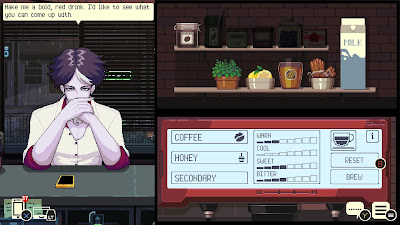Coffee Talk Episode 2: Hibiscus & Butterfly is a sequel to the first Coffee Talk, so it will be familiar to returning players. It is a visual novel styled game, with the bulk of its appeal and gameplay on the story. You play as the owner and barista of the coffee shop, Coffee Talk. The shop mainly opens late at night, and this attracts unique interesting characters. There is something about the place that just opens people up where they’re willing to talk and share about their current issues. Usually over the course of the game, they will find a way to resolve those said issues.
The game takes place in a world where different types of people and creatures exist. There are not only humans but also werewolves, banshees, and satyrs, just to name a few. They are effectively a stand-in for the different human races, and it works well here given the added visual variety. The game takes place over fifteen different days. During each day, different customers will come to speak about their own problems. A neat bonus is that there are a lot of returning characters from the first game and since around three in-game years have passed, we get an update on how they are now. Of course, there are new characters, with the main ones, the ones that show up in the cover art, being the satyr Lucas and the banshee Riona.
Just like the original game, this is a chilled and relaxing game. The soothing music and calming tone of the dialogue gives it plenty of charm. The gameplay is limited to satisfying customer orders. You can give them any drink but giving them the correct one will help you get to the best ending for each of their stories. To create a drink, you just need to select three ingredients. There are more ingredients this time around and by extension, there are more new drinks to create. These are all based on real drinks from different countries. This may not be the most engaging or complex gameplay but it is enough. To be honest, determining what the ingredients are for the best drink for the customer is not obvious for a lot of the time.
In addition to creating the drink, you can do a few additional things such as attempting to add latte art on top. Perhaps the biggest addition are key items that you get from customers over the course of the game. Then when you are presenting a drink to another customer, you can decide whether to also give them one of the key items. The effects of doing this range from achievements to being required for certain endings. The game’s graphics also basically look the same, so there’s little improvement there but it is a nice pixel art-style with a lot of detail in the character models.
Unlike the first game, there is a common story thread happening in the background that helps tie all of the days together. It doesn’t feel as aimless like it was meandering to nowhere. On the flipside, the game is all about expressing its own opinions on various matters and can border on being presumptuous in a few instances. Since you play the barista and each day only having a limited number of recurring customers that frequent the shop, each of their stories feel personal. A lot of them are relatable and none are so exaggerated that you feel detached from them.
The game takes around five hours to finish, although that depends on your reading speed. If you manage to get good endings for all the characters, then it will cover off most of their arcs. However, that doesn’t mean that you have seen all that the game has offered. There are different dialogue and story developments if you have given different drinks or forgotten to give them key items at specific points. Furthermore, there are still one or two smaller unresolved teases that you might want to see. Most of the “postgame” is getting these alternate scenes but there is an Endless mode. One part of it allows you to select three ingredients to create different drinks, so you’re free to experiment. The other part is a challenge mode where characters will request specific drinks and you need to produce it within the time limit.
Overall, Coffee Talk Episode 2: Hibiscus & Butterfly is not only more of what made the first game so good but improves upon it. The structure and storytelling are tighter with clearer objectives and a plot thread that helps tie all the different characters, and days, together. The fact that it only introduces two new main characters while furthering the stories of existing characters is a good choice, so that it is still familiar to returning players, but not be too repetitive either.
-----------------------------------------------






